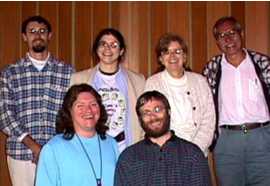|
|

|
 |
|
|
|
Colombian Mennonites Develop �Sanctuaries of Peace� by Val Liveoak During Christian Peacemaker Teams delegation visit to Colombia in April, 2000, we learned a lot about the peace witness of Mennonites there. (For a more detailed report see Special Reports: Report of Christian Peacemaker Teams' Exploratory Delegation to Colombia, April 7-17, 2000.) Starting
in 1991, when the new Colombian Constitution granted Protestant Churches
the same privileges granted to the Catholic Church, the Mennonite Justapaz
(Christian Center for Justice Peace and Nonviolent Action) opened a
seminary for young men (Mennonites and others) who did not want to participate
in obligatory military service. As seminarians, students in the �peacemaker
program� would receive exemptions�theoretically�and after finishing
their courses could then enter University level studies. While this
was a legal activity, it wasn�t one that was always effective�there
were young men whose status as seminarians was not recognized and who
were still obligated to serve if they wanted to continue studies. The
issue became so contentious that the Director of Justapaz received death
threats and went into exile for several months. The Mennonites� efforts
set an example for the other Protestant churches, however, and now most
of them have their own seminaries. It has also become easier for young
men to enter higher education without serving (I didn�t get the details�perhaps
it has become easier to buy exemptions) and the ones that enter the
seminary now are more interested in the content of the program, which
now also includes some young women. In addition, Justapaz has begun
to work with rehabilitating children who have been forced into serving
with the armed groups (currently mainly the guerrillas). After they
escape, their families are unable to protect them, much less educate
them, so they are staying in foster homes in Bogota.
During the last year or so, The Mennonites have developed the Sanctuaries of Peace program. As they described it, the process followed by fourteen of the eighteen Mennonite churches parallels FPTP�s Every Friends Church and Meeting a Center for Peacemaking. The Mennonite church in Teusaquillo, Bogota, has held several workshops on peacemaking, envisioning peace in their country, and conflict resolution, as well as heading up projects to work with people displaced by the violence. Justapaz and MENCOLDES, the Mennonite development agency, are doing similar work. The call to form Sanctuaries of Peace is �[a] message of nonviolence that discerns the times from the perspective of the Gospel and�fosters the formation of people for a peaceful and reconciled life. It promotes conscientious objection to military service and practice�[and] rebuilds the social fabric of our country.� So far, no congregation has been able to declare itself a physical sanctuary, but other parts of the program are being developed by ��a people filled with the Spirit and using their gifts, talents and ministries� assisting the victims of violence and �seeking their personal, family, spiritual and social recovery, and their holistic redemption in God.� As a part of their program, they are reaching out to faith groups internationally, asking congregations to also become a Sanctuary of Peace, offering �some possible lines of action for sisters and brothers outside Colombia:�
I believe
that in light of the increased military aid the US government will provide
to Colombia, our Friends Churches and Meetings will be led to respond
by becoming centers for peacemaking, and one way to do this will be
to formally join the Sanctuaries for Peace project of our sisters and
brothers in Colombia. My Dream for Peace in Colombia A part of the process of forming the Sanctuaries of Peace is envisioning a peaceful future. Some of �My Dream for Peace in Colombia� placed on a map at the Mennonite church Teusaquillo, Bogota:
TOP
• CURRENT Issue Index • PTN
Index • HOME |
||
